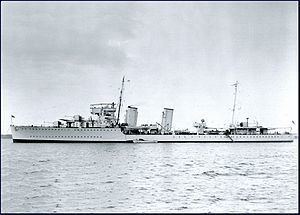Name Saguenay Commissioned 21 May 1931 Launched 11 July 1930 Draft 3 m | Decommissioned July 1945 Honours andawards Atlantic, 1939-1942 Length 98 m Beam 9.98 m | |
 | ||
Builder John I. Thornycroft & Company | ||
HMCS Saguenay was a River-class destroyer that served in the Royal Canadian Navy (RCN) from 1931-1945.
Contents
She was similar to the Royal Navy's A class and initially wore the pennant D79, changed in 1940 to I79.
History
She was built by John I. Thornycroft & Company at Woolston, Hampshire and commissioned into the RCN on 21 May 1931 at Portsmouth, England. Saguenay and her sister Skeena were the first ships specifically built for the RCN. Her first two commanding officers went on to become two of the most important Admirals of the Battle of the Atlantic. She arrived in Halifax, on 3 July 1931.
Second World War
For the first month of Second World War, Saguenay was assigned to convoy duties in the Halifax area. In late September 1939, she was assigned to the American and West Indies Squadron based at Kingston, Jamaica.
On 23 October 1939, the German-flagged tanker Emmy Friederich scuttled herself on encountering Saguenay in the Yucatan Channel, and thus became the Canadian destroyer's first war conquest. In December 1939, Saguenay returned to Halifax to join the local convoy escort force, with which she remained until 16 October 1940, when she was transferred to Greenock, Scotland to serve as a convoy escort on the North Atlantic run. On 1 December 1940, Saguenay was torpedoed 300 miles (480 km) west of Ireland by the Italian submarine Argo while escorting Convoy HG-47, and managed to return to Barrow-in-Furness largely under her own power, but with 21 dead and without most of her bow.
After repairs at Greenock, she returned to sea on 22 May 1941. Saguenay was assigned to Escort Group C-3 escorting convoys ON-93, HX-191, ONS-104, SC-90, ON-115, HX-202, ON-121, SC-98, ON-131, HX-210 and ON-141 prior to a collision while escorting SC-109. On 15 November 1942, Saguenay was rammed by the Panamanian freighter Azra off Cape Race, Newfoundland. The impact of the collision set off Saguenay's depth charges, which blew off her stern.
She made port at Saint John, New Brunswick, where her stern was plated over. On 23 May 1943, Saguenay was transferred to Halifax, to serve with the Western Ocean Escort Force working from Halifax and St. John's, Newfoundland. In October 1943 Saguenay was towed to Digby, Nova Scotia, as a tender assigned to HMCS Cornwallis, the Royal Canadian Navy's training depot for new entries (recruits). She was used for teaching seamanship and gunnery until 30 July 1945, paid off in late 1945, and broken up in 1946.
